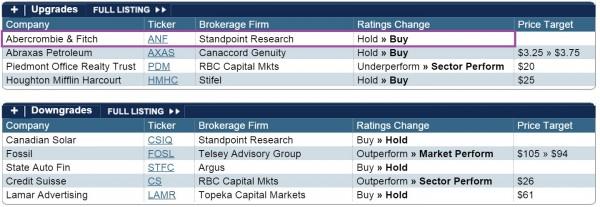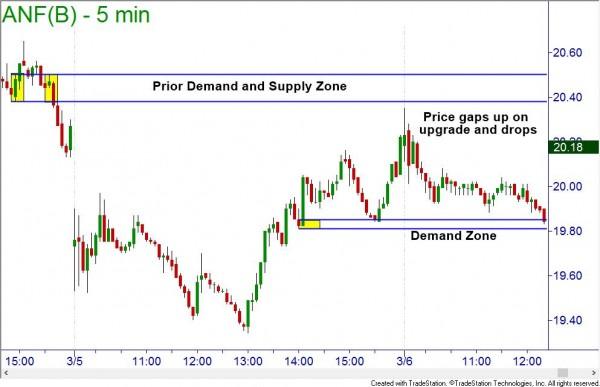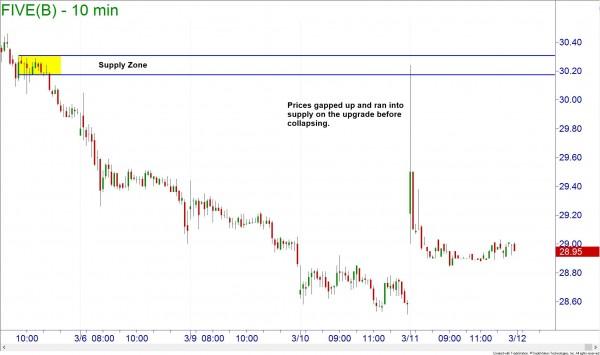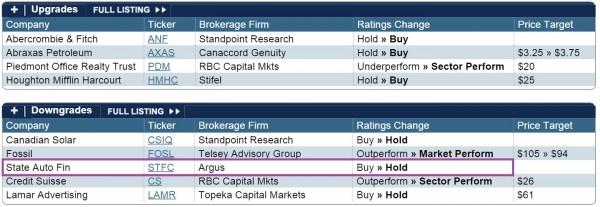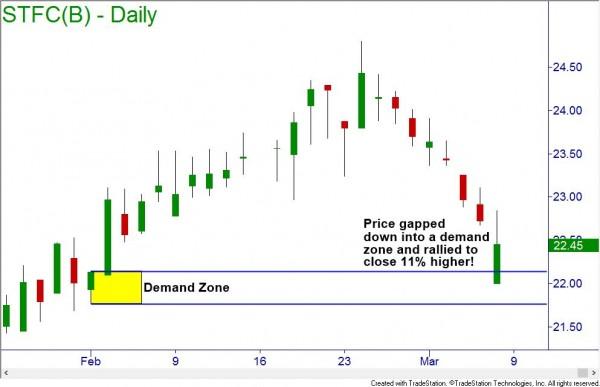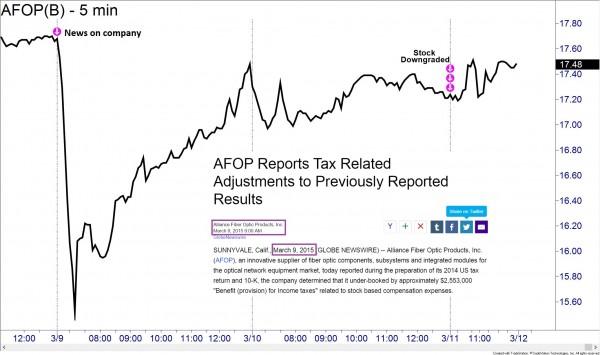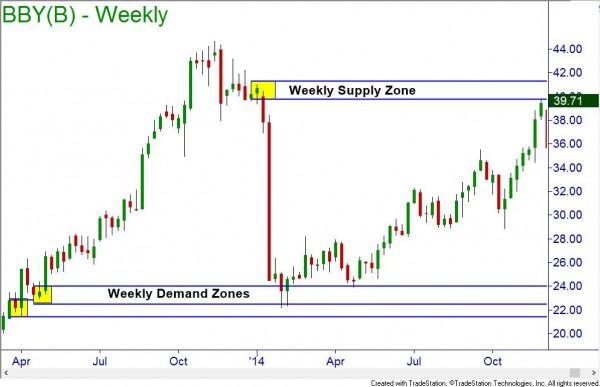Most people receive their financial education from television or a broker’s recommendation. They rely on the “expert’s” opinions rather than educate themselves and make their own. The problem is that the experts are not always looking out for your best interests. There have been numerous media releases about former brokers, and even a former SEC Director of Trading and Markets, discussing the conflicts of interests and how the equity markets have been rigged.
Further evidence of this bad advice are the upgrades and downgrades that brokerages provide to the public. Time after time the stocks that were upgraded saw a price jump into a supply zone only to see investors squander money as the broker’s information led them to losing choices.
The following upgrade on Abercrombie and Fitch on March 6th is an example. On the morning of the upgrade the stock gapped into a supply zone and those unfortunate people who bought the upgrade saw their money disappear.
Some may think this is a rare occurrence, but it happens more often than you would think. On the following week, March 11th, the upgrade for Five Below suffered the same fate.
Similar price movement happens when there are downgrades on stocks. Instead of stocks dropping after the brokerage lowered their expectations, the prices usually dropped into a demand zone where someone was able to purchase them at a great discount before the prices rose dramatically.
The inverse price movement doesn’t happen with every upgrade/downgrade, but it does happen enough that it should make you suspicious. Even when there is news on a security, it appears that the professionals take the opposite action of the novices who trade with the news. Alliance Fiber Optic had news that sent the stock’s price spiraling downward. It sharply rallied from strong buyers who took advantage of the wholesale prices. Two days later, there was a downgrade on the stock and, not surprisingly, the price rallied intraday after a small drop.
News on companies is often just as bad as the upgrades/downgrades. Most of the time novice traders will sell the stock when there is bad news and buy if there is good. When this happens, prices usually move directly into a supply or demand zone before professionals take advantage of the reversal that follows.
Best Buy (BBY) was on a great rally in 2013 into 2014 before a bad earnings report led to a sell off.
The sell off moved prices right into a weekly demand zone, where professionals took the opportunity to buy at wholesale prices.
So now that we know there is an inherent problem with the equity markets, what can be done about it to protect our money and allow us to profit in our trades and investments? Well, the first thing you should do is to remove yourself from the negative input. There is no need to watch retail news.
When I used to work as a hedge fund trader we paid thousands of dollars to get news as fast as possible. If you want the news first you must be prepared to pay a lot of money for it. Professional traders do not want to wait for the retail news because by the time it is broadcasted to the masses on television or via the internet, the professionals would have already positioned themselves to take advantage of the novice reaction to it.
Another simple solution is to trust your charts. News and recommendations influence people’s thoughts and perceptions. These thoughts and perceptions cause people to act and buy or sell securities. We can see these actions via our charts. By using Online Trading Academy’s Core Strategy, we can easily identify supply and demand zones where the professionals will take advantage of the novice news chasers.
We can then trade with the professionals who are usually on the correct side of the market. This increases our chances for success in our trades and investments and, most importantly, protects us from losing our precious capital. We need to reverse the old saying when it comes to brokerages; we need to do as they do, not as they say!
Neither Freedom Management Partners nor any of its personnel are registered broker-dealers or investment advisers. I will mention that I consider certain securities or positions to be good candidates for the types of strategies we are discussing or illustrating. Because I consider the securities or positions appropriate to the discussion or for illustration purposes does not mean that I am telling you to trade the strategies or securities. Keep in mind that we are not providing you with recommendations or personalized advice about your trading activities. The information we are providing is not tailored to any individual. Any mention of a particular security is not a recommendation to buy, sell, or hold that or any other security or a suggestion that it is suitable for any specific person. Keep in mind that all trading involves a risk of loss, and this will always be the situation, regardless of whether we are discussing strategies that are intended to limit risk. Also, Freedom Management Partners’ personnel are not subject to trading restrictions. I and others at Freedom Management Partners could have a position in a security or initiate a position in a security at any time.
Editors’ Picks
AUD/USD: Uptrend remains capped by 0.6650

AUD/USD could not sustain the multi-session march north and faltered once again ahead of the 0.6650 region on the back of the strong rebound in the Greenback and the prevailing risk-off mood.
EUR/USD meets a tough barrier around 1.0800

The resurgence of the bid bias in the Greenback weighed on the risk-linked assets and motivated EUR/USD to retreat to the 1.0750 region after another failed attempt to retest the 1.0800 zone.
Gold eases toward $2,310 amid a better market mood

After falling to $2,310 in the early European session, Gold recovered to the $2,310 area in the second half of the day. The benchmark 10-year US Treasury bond yield stays in negative territory below 4.5% and helps XAU/USD find support.
Bitcoin price coils up for 20% climb, Standard Chartered forecasts more gains for BTC

Bitcoin (BTC) price remains devoid of directional bias, trading sideways as part of a horizontal chop. However, this may be short-lived as BTC price action consolidates in a bullish reversal pattern on the one-day time frame.
What does stagflation mean for commodity prices?

What a difference a quarter makes. The Federal Reserve rang in 2024 with a bout of optimism that inflation was coming down to their 2% target. But that optimism has now evaporated as the reality of stickier-than-expected inflation becomes more evident.
RECOMMENDED LESSONS
Making money in forex is easy if you know how the bankers trade!
Discover how to make money in forex is easy if you know how the bankers trade!
5 Forex News Events You Need To Know
In the fast moving world of currency markets, it is extremely important for new traders to know the list of important forex news...
Top 10 Chart Patterns Every Trader Should Know
Chart patterns are one of the most effective trading tools for a trader. They are pure price-action, and form on the basis of underlying buying and...
7 Ways to Avoid Forex Scams
The forex industry is recently seeing more and more scams. Here are 7 ways to avoid losing your money in such scams: Forex scams are becoming frequent. Michael Greenberg reports on luxurious expenses, including a submarine bought from the money taken from forex traders. Here’s another report of a forex fraud. So, how can we avoid falling in such forex scams?
What Are the 10 Fatal Mistakes Traders Make
Trading is exciting. Trading is hard. Trading is extremely hard. Some say that it takes more than 10,000 hours to master. Others believe that trading is the way to quick riches. They might be both wrong. What is important to know that no matter how experienced you are, mistakes will be part of the trading process.
